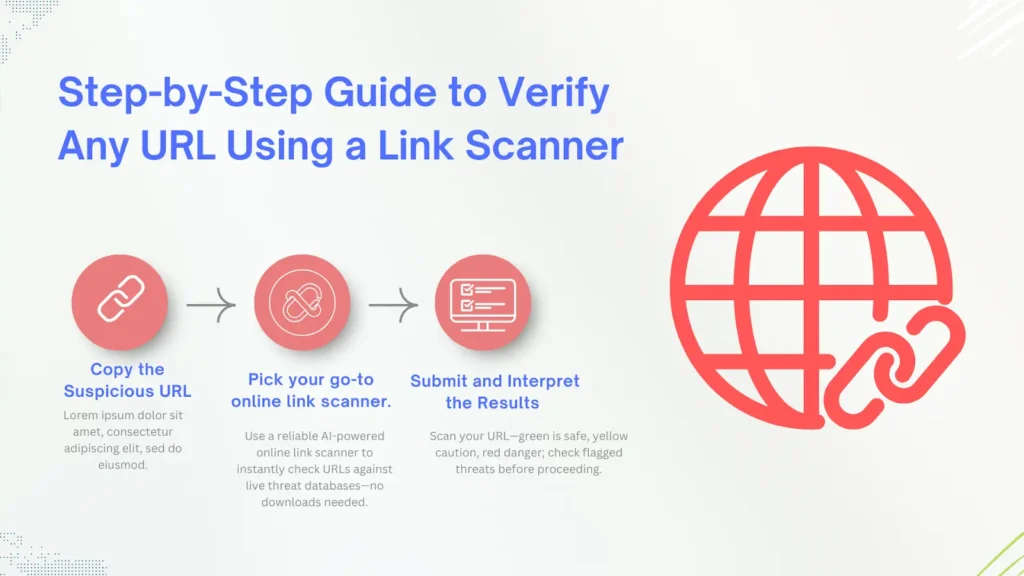Think about how many links you’ve clicked today. Most of us tap away without a second thought. But here’s the wake-up call: phishing attacks jumped 48% in 2024. That’s not a typo.
One careless click could empty your savings, hijack your identity, or encrypt your entire hard drive with ransomware. Sounds dramatic? It happens every single day to regular people. The good news? You don’t need a computer science degree to stay safe. This walkthrough teaches you exactly how to verify URL legitimacy before clicking, using straightforward tools that take minutes to learn.
Understanding URL Verification and Why It Matters
Dangerous links don’t announce themselves with flashing red flags anymore. Attackers have perfected the art of camouflage, making verification absolutely essential in today’s web landscape.
The Anatomy of Malicious URLs
Cybercriminals play psychological tricks with web addresses. They’ll substitute letters with lookalike numbers (swap the letter “o” for a zero). They craft domains that almost mirror trusted companies maybe adding one extra letter or using a different extension. Shortened links? Perfect cover for hiding sketchy destinations.
Some fraudsters even snag official-sounding domain endings to boost their credibility. Here’s what keeps security experts up at night: these impostor addresses can fool you in a split-second glance.
When You Should Always Check Website Safety
Trust your gut. You need to check website safety whenever alarm bells ring, even quietly. Random emails claiming to be your bank. Direct messages from accounts you don’t recognize. Texts announcing deliveries you never ordered.
Job opportunities promising ridiculous salaries for minimal work. Scrutinize everything. Even links from people you know can be compromised if their accounts got hijacked without them realizing it. Cyber threats aren’t slowing down—they’re accelerating. Knowing what makes a URL hazardous gives you a fighting chance. Now let’s dig into the practical tools that actually protect you.
Step-by-Step Guide to Verify Any URL Using a Link Scanner
You don’t need technical superpowers for this. Just a smart approach and the right tool to examine suspicious links before they wreak havoc.
Step 1: Copy the Suspicious URL (Without Clicking)
This step separates the cautious from the careless—never click to copy. On your laptop or desktop, hover your cursor over the link and right-click to grab “Copy link address.” Using your phone? Long-press the link until copy options pop up.
Checking email? Often you can hover to reveal the actual destination without clicking anything. This tiny habit prevents accidental trips to malicious territory.
Step 2: Choose Your Preferred Online Link Scanner
To properly scan suspicious links, you need a trustworthy online link scanner. Cybersecurity specialists offer browser-based tools that analyze URLs instantly—zero downloads necessary.
Built on two decades of protection experience, this AI-driven link scanner cross-references websites against live threat intelligence and continuously updated databases. Paste any questionable link into verification tool, and you tap into their deep expertise for fast, trustworthy answers about site safety.
Step 3: Submit and Interpret the Results
Drop your URL into the online link scanner and click submit. Give it a few seconds. You’ll get a safety verdict—typically green means you’re good, yellow signals proceed carefully, and red screams danger.
Notice what specific threats got flagged: malware signatures, phishing characteristics, weird redirects. When multiple detection systems raise red flags? That’s your cue to back away immediately. Clean results aren’t iron-clad guarantees, but they dramatically cut your risk exposure.
This basic scanning workflow handles most everyday situations perfectly fine. But sometimes you need to go deeper, especially if you’re technically inclined or facing high-stakes scenarios.

Advanced Verification Techniques
Standard scanning doesn’t always cut it. These extra verification layers provide additional protection when dealing with especially suspicious links or critical security situations.
Manual URL Inspection Methods
Before you even scan, eyeball the URL yourself. Hunt for typos in the domain name. Spot weird characters or sketchy subdirectories. Does the domain extension make logical sense? Commercial sites use .com, government agencies stick with .gov, and so on. Watch out for absurdly long URLs stuffed with random character strings or multiple redirect hops. Reputable organizations almost never use obscure extensions or convoluted web addresses.
Using Multiple Detection Engines
Never bet everything on one scanner’s judgment. Compare findings across different platforms for comprehensive coverage. Multi-factor authentication blocks 99.9% of automated attacks, similarly, multiple verification services catch threats individual scanners might overlook.
Getting ambiguous results from one tool? Test two or three more before deciding whether that link deserves your trust.Link scanners pack serious detection power for established threats. But leaning exclusively on automated scanning? That creates vulnerabilities you can’t afford.
Common Threats Link Scanners Detect
Understanding what these tools hunt for helps you spot danger signs even before running a scan. Here’s what modern URL verification catches regularly.
Phishing Websites
These counterfeit sites impersonate real businesses to snatch your passwords or payment details. Scanners identify them by matching visual components, examining domain registration dates (brand-new sites cloning established brands raise instant suspicion), and studying form behaviors. Phishing pages frequently display mismatched security certificates or lack proper safety indicators, red flags that automated systems spot quickly.
Malware Distribution Sites
Certain URLs automatically inject viruses, trojans, or ransomware onto your device. Scanners search for recognizable malicious code signatures, suspicious automatic downloads, and connections to hacker command centers.
They identify sites with drive-by download mechanisms that install programs without asking permission, protecting you from infections your regular antivirus might not catch until damage is done. Even when you follow every best practice and layer multiple defenses, understand this reality: no scanner delivers absolute protection.
Best Practices for URL Safety Beyond Scanners
Technology alone won’t save you. Smart habits combined with automated tools create your strongest shield against evolving digital threats.
Implementing Multi-Layer Security
Add browser extensions that automatically warn about dangerous sites before you click. Turn on your browser’s native safe browsing alerts. Run antivirus software with active web monitoring. Keep your operating system and applications current with the latest security updates. Password managers equipped with phishing detection stop you from entering credentials on fake sites by auto-filling only on verified legitimate domains.
Staying Updated on Emerging Threats
Hackers never stop innovating. Subscribe to respected cybersecurity newsletters, enable security notifications from major tech platforms, and join online safety communities. Knowing current scam patterns helps you recognize threats before databases get updated. That gap between new attack emergence and scanner updates creates a vulnerability window that only awareness can bridge.
Acknowledging these built-in limitations keeps you appropriately vigilant and prevents dangerous overconfidence.
Staying Safe in an Uncertain Digital World
Checking URLs before clicking isn’t overcautious paranoia—it’s a basic survival strategy in 2024. Those few seconds spent verifying a suspicious link through proper tools can spare you from life-altering consequences.
Build scanning into your routine whenever you encounter surprise messages, unfamiliar contacts, or offers that sound impossibly perfect. Bookmark dependable scanning services, activate browser protections, and keep learning about new threats. Your digital wellbeing depends on staying ahead of cybercriminals who constantly sharpen their techniques.
Your Questions About URL Safety Answered
How accurate are scanners in detecting malicious URLs?
Today’s scanners nail 95-98% of known threats but stumble with brand-new attacks and zero-day vulnerabilities. They excel at catching established dangers but can’t predict every possible threat. Combining scanning with personal inspection and cautious browsing creates your best defense strategy.
Can I scan shortened URLs like bit.ly links?
Absolutely—most scanners expand and examine shortened URLs. These compact links carry extra danger since you can’t preview where they lead. Always scan them first, because attackers love hiding malicious destinations behind shorteners to dodge visual checks and email security filters.
What should I do if a scanner shows mixed results?
Play it safe. When even one reputable scanner flags something, avoid that link unless it’s absolutely critical. Contact the supposed sender through a separate communication channel to confirm legitimacy, or search independently for the content instead of clicking through.
Also Read–How LATAM’s Tech Talent Is Driving Digital Transformation Globally

